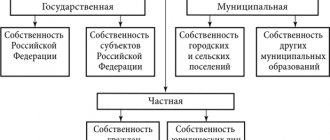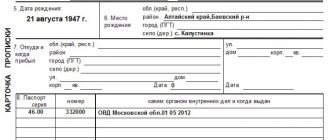Property concept
Definition 2
Property is understood as a certain form of appropriation by a citizen or legal entity of specific material assets. It allows you to use and dispose of property at the discretion of its owner.
Disposing of property means the ability to sell goods, exchange them for others, rent or donate them, and carry out other similar actions. The main essence of property is that in order to change the rights to property, two entities are required, between whom an agreement is concluded.
Finished works on a similar topic
- Course work Types and forms of ownership of real estate 440 rub.
- Abstract Types and forms of ownership of real estate 280 rub.
- Test work Types and forms of ownership of real estate 240 rub.
Receive completed work or specialist advice on your educational project Find out the cost
In order to have the most complete understanding of the concept of property, it is necessary to distinguish the subjects and objects of property.
Property subjects are the owners of specific values, i.e. owners. Property objects are direct material or intangible benefits belonging to the owner.
All subjects interact with each other, resulting in the formation of various relationships between them.
The main properties are:
- Property, which includes movable and immovable property, cash, securities. Real estate is land, buildings, water bodies, forests, etc. Movable property is various objects that do not belong to real estate, i.e. vehicles, goods, raw materials, etc.;
- Works and services;
- Valuable data;
- Intellectual property, which includes inventions, works of science or art, etc.;
- Intangible goods that usually belong to a person from birth, and can also become property by law. Intangible benefits include human health, reputation, private life, etc.
Do you need proofreading or review of academic work? Ask a question to the teacher and get an answer in 15 minutes! Ask a Question
Property can be:
- Private, which appears as a result of denationalization of the property in respect of which privatization is being carried out;
- Collective;
- Cooperative. A cooperative is a special association of citizens formed on a voluntary basis. All members of the cooperative jointly own various objects;
- Civil, which is formed with the help of labor income of citizens participating in social reproduction;
- Property of a joint stock company. In this case, the property is acquired by the organization at the expense of income received from the sale of securities;
- Individual labor. This type of ownership presupposes that a person is both an owner and a worker, and the purpose of work is to satisfy social needs.
Types of real estate ownership
The most common form of real estate ownership is private ownership. A document confirming this right allows a specific person to dispose of a certain piece of real estate at his own discretion. However, there are different types of real estate ownership in terms of private ownership. Thus, individual and common property are distinguished. The second type occurs in cases where one indivisible object requires two or more owners. In this context, it is worth moving to a joint form of ownership, which is also considered as common, but without the allocation of specific shares. If it is intended to divide the property between the owners, then we can talk about another form of ownership - shared ownership. Common property involves the formation of single shares between the owners, but their specific sizes are not specified. This could be an apartment of the spouses, which was purchased during marriage using common financial resources.
Real estate ownership and its forms
Any property must belong to someone by right of ownership. All information about the owner, characteristics of the property and the emergence of ownership rights can be found in the unified Rosreestr database. According to Article 212 of the Civil Code of the Russian Federation, the following forms of ownership of real estate are distinguished:
- Private, in which the owners of real estate are individuals or legal entities;
- Municipal, in which ownership rights to property are held by local governments;
- State, when the owner of the property is the state or a subject of the Russian Federation;
- Other forms provided for by current legislation.
The right to own property is confirmed by a corresponding certificate issued by Rosreestr, as well as title documentation, for example, a purchase and sale agreement, a deed of gift.
Let's take a closer look at the listed forms of real estate ownership.
Municipal and state property arises only in cases provided for by law. Not every property can become the property of the state or municipality. The state's ownership rights to specific real estate are limited, since it has the right to dispose of property only within the framework of respecting the interests of society.
State property can be federal or the property of a constituent entity of the Russian Federation. The first type means that real estate belongs to the Russian Federation, and the second - to regions, republics, etc.
The state and its subjects own the property that is required to carry out specific functions, for example, buildings for the needs of the RF Armed Forces, federal roads, some plants and factories.
This type of property right also includes schools, parks, public gardens, and kindergartens.
Private property is property owned by a citizen or commercial organization. Such real estate includes apartments, private houses, warehouses, offices, garages, bathhouses, etc.
Any person can acquire ownership of real estate in one of the following ways:
- Through privatization;
- Through purchase;
- Receiving as a gift;
- Inheritance;
- Construction.
Private property is divided into individual property, when only one person owns the property, and common property, in which case several persons have the right to the property at the same time.
Common property in turn is divided into:
- Joint - shares are not allocated, arises when spouses purchase housing or during privatization;
- Shared, when a clear share of each co-owner is allocated.
Commentary on Article 130 of the Civil Code of the Russian Federation
1. The division of things into immovable and movable is based on their natural properties. Immovable things, as a rule, cannot be moved; they are individually determined and irreplaceable. Movables can move freely and be both individually defined and generic.
2. Clause 1 of the commented article, firstly, includes objects of natural origin as real estate - plots of land, subsoil plots and isolated water bodies. It should be noted that natural resource laws define these objects somewhat differently in relation to property rights. Thus, the Subsoil Law recognizes the subsoil as an object of state ownership as a whole as part of the earth’s crust located below the soil layer, and in its absence, below the earth’s surface and the bottom of reservoirs and extending to depths accessible for geological study and development within the territory of the Russian Federation , its continental shelf and maritime exclusive zone. Subsoil plots in the form of a mining allotment are considered by the Law as objects that are permitted to be provided for use (Article 7).
The Water Code considers a water body or part of it as an object of water relations. A water body represents surface waters and the lands covered by them and associated with them: the bottom and banks of the water body (Article 7). The object of state ownership is water bodies, including isolated water bodies (closed reservoirs). Only isolated water bodies can be in private and municipal ownership (Articles 35, 39, 40). The object of the right of use or property right (public or private easement) can also be a water body as a whole or a part of it (Articles 43, 46).
Secondly, real estate includes everything that is firmly connected to the land: buildings, structures, forests, perennial plantings and other objects, the movement of which is impossible without disproportionate damage to their purpose. These objects are recognized as real estate as long as they are connected to land. Being separated from it, they become movable things.
3. The Civil Code also includes some movable things by their natural properties as real estate - aircraft and sea vessels, inland navigation vessels and space objects. Real estate is only those that are subject to state registration by bodies authorized to exercise control over these objects.
The concept of these vehicles is disclosed in transport charters and codes, and space objects - in international conventions (treaties, agreements). An aircraft is a flying machine maintained in the atmosphere by interaction with the air other than that reflected from the surface of the earth or water. A seagoing or inland waterway vessel is a self-propelled or non-self-propelled floating structure used for the purposes of merchant shipping or navigation, respectively. Russian legislation (RF Law of August 20, 1993 N 5663-1 “On Space Activities” - RG, 1993, October 6, N 186) does not define a space object. International documents include objects launched into space or delivered to or built on celestial bodies. Some of the international acts consider not only objects as a whole as space objects, but also their component parts, as well as their delivery vehicles (part of them), and indicate the types of space objects (stations, installations, equipment, spaceships).
The procedure for registering aircraft is determined by Art. 33 VK. Civil vessels are subject to registration in the State Register of Civil Aircraft of the Russian Federation. Maintaining the register is entrusted to a specially authorized body in the field of civil aviation. State aircraft are registered in the manner established by a specially authorized body in the field of defense in agreement with specially authorized bodies that have state aviation units.
Sea vessels are registered in the manner prescribed by Art. 33 - 47 KTM, and inland water navigation vessels - Art. 15 - 25 kWW. Sea vessels are subject to registration and are subject to technical supervision in accordance with Art. 23 of the KTM, and vessels that are temporarily granted the right to sail under the State Flag of the Russian Federation, and in inland water transport - the vessels specified in Art. 17 kVVT.
Seagoing vessels are entered either in the State Ship Register of the Russian Federation, or in the ship book, or in the bareboat charter register, and inland water transport vessels are registered in the State Ship Register of the Russian Federation or the ship book. The vessels listed in paragraphs. 1 - 3 tbsp. 17 KVVT, are registered in the State Ship Register of the Russian Federation. Vessels not listed in these paragraphs are registered in the ship's book. The procedure for state registration of ships in the State Ship Register of the Russian Federation is determined by the federal executive body in the field of transport, and in the ship book - by bodies authorized to do so by the Government of the Russian Federation.
Order of the Ministry of Transport of Russia dated September 26, 2001 N 144 approved the Rules for State Registration of Ships (BNA RF, 2001, N 49). In accordance with them, vessels are subject to state registration, incl. mixed navigation (river-sea), ferries, dredging and bottom-cleaning equipment, floating cranes and other technical structures of this kind (clause 1), as well as those being built on the territory of the Russian Federation, with the exception of foreign ones, which are registered in the register of leased foreign vessels (clause . 5). The bodies carrying out state registration are state river navigation inspections of basins, as well as captains of river ports located at river mouths (for mixed navigation vessels).
Space objects are subject to state registration, the procedure for which should be determined by the Government of the Russian Federation. Along with this, the 1975 Convention on the Registration of Objects Launched into Outer Space is in force in this area.
4. The Civil Code does not exclude the possibility of extending the real estate regime to other property, in addition to that specified in paragraph. 2 paragraph 1 of the commented article, but only on the basis of the direct instructions of the law. So, in accordance with Art. 132 of the Civil Code, real estate is recognized as an enterprise as a whole as a property complex. The Law on Homeowners' Associations defines real estate as a single complex of real estate, including a land plot, a residential building and other real estate located on it (Article 5), as well as mechanical, electrical, plumbing and other equipment located outside or inside the premises and serving more than one premises, and other objects intended to serve a single complex of real estate of the condominium and serving its use (Article 7). The Law on Registration of Rights to Real Estate classified residential and non-residential premises as part of a building as real estate (Article 1).
5. The Civil Code establishes the features of the legal regime of real estate:
1) ownership and other real rights to real estate, restrictions on these rights, their emergence, transfer and termination are subject to state registration (see commentary to Article 131);
2) the obligation, the subject of which is real estate, is, as a general rule, fulfilled at its location;
3) the right of ownership to newly created real estate or transferred under an agreement arises from the moment of state registration of either this real estate (see commentary to Article 219) or the transfer of ownership of it to the buyer (Article 551);
4) a special procedure has been established:
acquisition of ownership rights to ownerless real estate (see commentary to Article 225) and longer periods of acquisitive limitation on real estate (see commentary to Article 234);
foreclosure on mortgaged real estate (see commentary to Article 349);
disposal of real estate owned by state and municipal enterprises (see commentary to Article 295);
5) there are special rules for transactions with real estate, providing for the dependence of rights to a land plot from rights to real estate. Thus, a pledge of real estate (mortgage) is allowed only with a simultaneous mortgage under the same agreement of the land plot on which it is located, or its part necessary for its use, or the right of use of the mortgagor for this plot or its part (see commentary to Art. 340).
When selling or leasing buildings, structures and enterprises, simultaneously with the transfer of ownership to the buyer, the rights to that part of the land plot that are occupied by real estate and necessary for its use are transferred. If only a plot of land is sold or leased, the owner of the property retains the right to use that part of it that is occupied by this property and is necessary for its use, on the terms provided for in the contract, and in their absence, the right of limited use (easement) (Article 552 , 553 and 652, 653).
The provisions of the Civil Code on donation and rent agreements do not contain similar rules regarding real estate and the land plot on which it is located. It seems that the rules for the purchase and sale of real estate should be applied to them by analogy.
6. Movable property is things, including money and securities, that are not classified as real estate by the Civil Code and other laws.
Rights to movable things (as a general rule) are not subject to state registration. However, the law may provide for the need for such registration for certain types of movable property. Thus, at present, the Decree of the Government of the Russian Federation of August 12, 1994 N 938 “On the state registration of motor vehicles and other types of self-propelled equipment on the territory of the Russian Federation” is in force (SZ RF, 1994, N 17, Art. 1999).
Types of private property
There are four subtypes or categories of types of private ownership of an apartment:
- individual;
- general joint;
- common lobe;
- shared
Part of the expert community also classifies collective property as private property. Let's look at all five forms of real estate ownership in more detail.
Individual property
Applies when the only occupant is registered in the apartment or he alone owns the living space (other family members have issued a waiver). Legislatively, the owner has the right to solely own, use and dispose of housing.
In everyday life, there are other names for the type of ownership in question for an apartment, house or land plot - personal or full.
You can get it by:
- privatization;
- purchases;
- inheritance or gift;
- participation in shared construction or housing partnership.
This type is fixed in a special register - USRN. The owner takes ownership of the apartment not after signing the transaction, but after entering it into the register.
Total share
This type of property is described in Article 245 of the Civil Code. The text of the article states that shared ownership occurs in the case when the property parts of the participants are not determined. In this case, the shares are considered equal. Accordingly, taxes and utility costs for the apartment are divided equally for all co-owners. Actions are fully regulated by Articles 245-252.
Shares can be:
- ideal, not distinguished in natural definition (expressed as a fraction ½ or 1/3);
- real, identified in kind (prescribed in a specific quadrature).
You can also obtain this ownership right, like the previous one, in a variety of ways:
- through privatization;
- through a gift agreement or inheritance;
- registration of a purchase and sale transaction, etc.
If the owners divide the property (apartment, house) into specific parts (real shares) and sign an agreement about this, then they talk about shared ownership.
Only separate rooms can be divided. For example, rooms in an apartment are divided into real shares, while the bathroom, corridors and kitchen are not (and belong to the common shared property divided into ideal shares).
When selling such property, other participants will have first priority in purchasing.
Share
The main difference between shared ownership and common ownership is that in the first case the shares in the apartment are not defined, therefore, they are equal (Article 245 of the Civil Code). In the second option, unequal parts are distinguished, including in percentage terms.
The number of owners, as well as shares, can be anything. As a rule, this term is used when privatizing communal services. For each co-owner, a specific area or a separate room in the apartment is prescribed. Taxes and utility bills are paid in exact proportions.
It is possible to sell your part even without the approval of other shared owners of the apartment. The only condition is that they have a legal advantage when buying out a share.
Common joint property
In this right, shares are not allocated at all. Community property arises only between close relatives (that is, spouses and their minor children). They are endowed with the same rights - to own, use and dispose of joint property. This is enshrined in Article 253 of the Civil Code. The USRN register lists all participants in the common property.
Most often, this right is applied when privatizing an apartment. At the same time, it will not be possible to buy housing in common ownership for 2-3-4 people, not close relatives, only in shared ownership. This type of purchase is provided only for spouses.
Dispositions, such as the sale of an apartment, are possible with the consent of all members.








